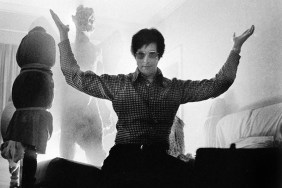
In my entire career, I only made big bullshits. . . . I’m just a craftsman. A romantic craftsman,” Mario Bava once said of his films. Despite his flippant, and often humble, protests, the director displayed a stunning artistry and elegance that betrayed his painterly ambitions a style his successors spent their careers reflecting on, including his most devoted pupil, Dario Argento. Bava, too, had teachers. His 1963 film The Girl Who Knew Too Much (on Blu-ray from Kino Lorber May 19) pays homage to Alfred Hitchcock, the original Master of Suspense. In doing so, the film ultimately ushered in a new brand of thriller: one also inspired by the gialli, cheap mystery paperbacks, popular in Italy, that fixated on lurid crimes.
The narrative is a fairly straightforward whodunit, full of the red herrings that the giallo genre became known for. Nora Davis (Letícia Román), a young American woman, travels to Rome where she witnesses a murder. Shes obsessed with pulpy mystery novels, so she has very little credibility with the authorities, who deduce that her story is the product of an overactive imagination. Their sexist view of women also arouses doubt. She attempts to uncover the killers identity with the help of John Saxons Marcello, a kindly doctor who has eyes for Nora, as well.
The Girl Who Knew Too Much became the template for the beloved giallo tropes genre audiences would later crave: an amateur detective, an inept police force, a few nonsensical detours, and of course, a rising body count. In case the films title didnt give it away riffing on Hitchcocks 1934 film The Man Who Knew Too Much Bava inserts self-referential touches, such as a Hitchcockian cameo, during which the filmmakers eyes are visible behind a portrait on the wall, following Nora.

Bava expertly crafts a tense, atmospheric setting for our Nancy Drew, but cleverly undermines the films aura of dread with unexpected gags. Theres the Vaudevillian slip-on-a-banana-peel scene with Saxons heroic Romeo, who becomes tangled in a booby trap, and a split-second shot of Noras aunt, who looks like a bedsheet ghost when we first meet her. Bavas bookend, psychoactive narrative is more commedia all’italiana than horror, too, but simultaneously reinforces giallos heady alternate reality, and the set of rules and codes by which it operates.
By the end of The Girl Who Knew Too Much, which would be Bavas final black-and-white production, Noras detractors have been disproven. The narrator, who guides us through the mystery with amusing alarmism, has vanished. Its Noras voice we hear as she questions whether the murders were truth or fiction. She was warned by the detectives that her mystery novellas were dangerous books. Nothing is so black and white, but the maestro knows that like Nora, we cant resist reaching for the forbidden fruit.
—
Alison Nastasi is a giallo addict and the weekend editor of Flavorwire. You can find her talking about exploitation cinema, VHS, occult oddities, Hammer horror, and other genre fare on Twitter.









